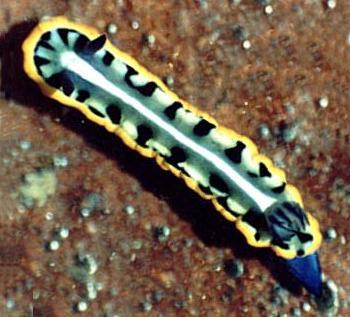
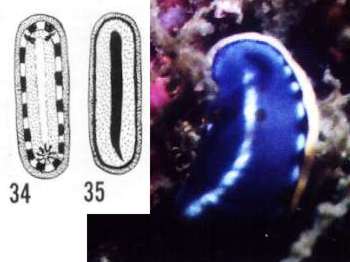
Mexichromis kempfi
(Ev. Marcus, 1970)
Order: NUDIBRANCHIA
Suborder: DORIDINA
Superfamily: EUDORIDOIDEA
Family: Chromodorididae
DISTRIBUTION
Caribbean to Sao Paulo, Brazil.
PHOTO
Upper: Santa Marta, Colombia - Caribbean coast. 15mm long. Photo: Phanor Montoya. Lower left: Sketches of holotype by Dr Marc Kempf (from Marcus, 1970). Lower right: Laje e Santos, off Sao Paulo, Brazil. Photo: Armando de Luca Jr.
Note added 4 March 2005: Previously on the Forum as Chromodoris kempfi.
This species is unlikely to be a species of Chromodoris. from the description of the jaw rodlets - described as multicuspid, and the small and narrow radular ribbon (50 x 35.0.35), it is most likely to be a species of Mexichromis.
It was described by Marcus from two specimens from nthn Brazil, the colour description being based on the sketches, reproduced here, and the colour notes of the collector, Dr Marc Kempf, after who the species was named. The animal is blue with an orange mantle border and a white mantle midline. Around the mantle border, Kempf described "between the orange and the blue is a band of seven darker blue and seven white spots, on either side". The foot, sides of body, gills and rhinophores are blue. Armando de Luca's photo from Sao Paulo, matches that description well. I would consider Phanor Montoya's colour form from Colombia to be a lighter colour form of this species, and a link to the even whiter animals described on the Forum from Florida [message #1415 ].
It is possible that a new species, Mexichromis molloi Ortea & Valdés in Ortea, Valdés & García-Gómez, 1996, from Venezuela, is also a colour variation. It has a blue mantle, with a white median line, and orange-yellow mantle border, inside of which is a dark blue band and then a white band. The gills and rhinophores are blue and there is a single white line along each side of the blue body.
-
Marcus, E. (1970) Opisthobranchs from northern Brazil. Bulletin of Marine Science, 24: 922-951.
-
Ortea, J., Valdés, A. & and García-Gómez, J.C. (1996) Revisión de las especies atlánticas de la familia Chromodorididae (Mollusca: Nudibranchia) de grupo cromático azul. [Review of the Atlantic species of the family Chromodorididae (Mollusca: Nudibranchia) of the blue chromatic group.] Avicennia, 1996, Suppl. 1: 1-165.
Rudman, W.B., 2003 (March 5) Mexichromis kempfi (Ev. Marcus, 1970). [In] Sea Slug Forum. Australian Museum, Sydney. Available from http://www.seaslugforum.net/find/chrokemp
Related messages
Re: Mexichromis kempfi from Little Cayman, British West Indies
November 27, 2008
From: Vinicius Padula
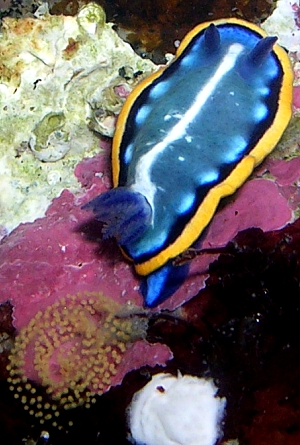
Concerning message #22075:
Dear Deborah and Bill,
Here is another photograph of the common pattern of Mexichromis kempfi and its large eggs from the southeastern Brazilian coast.
Locality: Cabo Frio, 10 metres, Rio de Janeiro, Brazil, Atlantic, 9 December 2007. Length: 15 mm. Photographer: Vinicius Padula.
I don't know any record of specimens with a whitish background colour in the same area. And also of the blue form from the Caribbean.
We know very little about M. kempfi from northern Brazil, only the original description, and from other Brazilian localities. The original specimens fits better with the blue form. At the same time, as Bill suspects and I support, Mexichromis molloi Ortea & Valdés in Ortea, Valdés & García-Gómez, 1996 from Venezuela could be a color variation of this species, and may represent the presence of the blue form in the Caribbean Sea.
I hope that soon someone will take pictures of the eggs of the whitish form from the Caribbean and we can go ahead in this discussion.
Best wishes,
Vinicius
viniciuspadula@yahoo.com
Padula, V., 2008 (Nov 27) Re: Mexichromis kempfi from Little Cayman, British West Indies. [Message in] Sea Slug Forum. Australian Museum, Sydney. Available from http://www.seaslugforum.net/find/22082Thanks Vinicius,
Certainly a look at the egg ribbon of the whitish form could give us a valuable clue. However, as I have said before we know nothing of the anatomy of the whitish animal and very little of the blue Brazilian animal. As I discuss in a earlier message [#6448], my tentative placing of it in Mexichromis was based solely on Marcus's original, very brief description of the radula.
I hope someone will be able to find and send you some specimens of the whitish Caribbean form so you will be able to compare the anatomy and decide if we have two species, or one species with various colour forms.
Best wishes,
Bill Rudman
Mexichromis kempfi from Little Cayman, BWI
November 26, 2008
From: Deborah Chambers
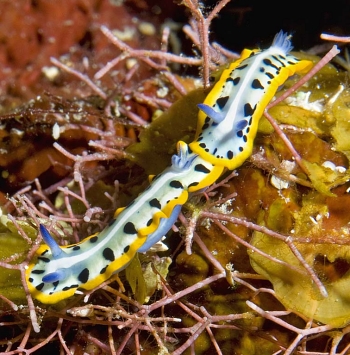
Howdy, Bill,
I think this is a pair of Mexichromis kempfi that I photographed on Little Cayman Island in October 2008.
These are not real common on Little Cayman (or at least they're hard to spot!), so I thought I would submit the photo. It's the first time I've seen two of them together.
Locality: Little Cayman Island, 15 meters, Cayman Islands, BWI, Caribbean Sea, 19 October 2008, Spur and groove coral formations. Length: 20 mm. Photographer: Deborah Chambers.
Cheers,
Deborah Chambers
witw_deborah@yahoo.com
Chambers, D. S., 2008 (Nov 26) Mexichromis kempfi from Little Cayman, BWI. [Message in] Sea Slug Forum. Australian Museum, Sydney. Available from http://www.seaslugforum.net/find/22075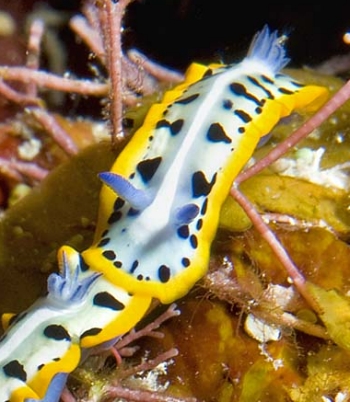
Dear Deb,
Thanks for these photos. As you will see from earlier messages, these Caribbean animals with a whitish background colour are rather different from the darker blue animals from Brazil on which the species was based. I suspect we have enough intermediate colour forms to show that they are all colour forms of one species, but as Vinicius Padula suggested [message #19200], it would be valuable to compare the anatomy of these different forms.
It's intere sting to see another example of animals of M. kempfi following each other in single file like this [see trailing Fact Sheet]. If you do ever see this species laying eggs it would be nice to have a photo to compare with the one on Vinicius Padula's message. If the eggs of the Caribbean animals are different from those of the Brazilian animals, it would indicate we are probably dealing with more than one species.
Best wishes,
Bill Rudman
Re: Mexichromis kempfi from Brazil
January 12, 2007
From: Vinicius Padula
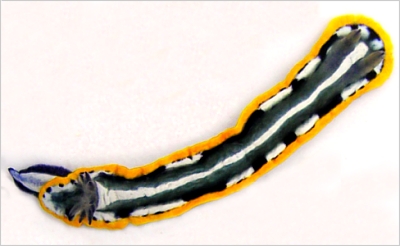
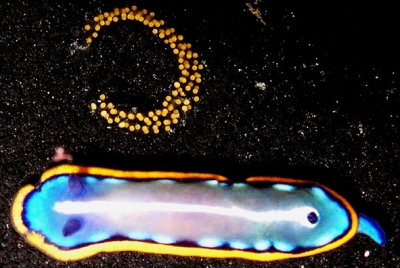
Concerning message #19152:
Dear Bill,
Concerning this message I agree with you about Mexichromis kempfi. Armando's photos from São Paulo and my photos here from Rio de Janeiro match more with the original description of this species, from the northeast of Brazil. There is a color variation in specimens observed here in Rio, but the specimens from the Caribbean region looks so much different and I'm not sure that they belong to the same species.
I don't believe that the bright pink egg ribbon in "Caribbean Sea Slugs" belongs to the slug alongside. I'm sending a picture of an egg ribbon of M. kempfi that were laid in the laboratory, with large, yellow eggs.
I'm looking for specimens from the Caribbean Sea to make anatomical studies and compare to the Brazilian material.
Regards,
Vinicius Padula
viniciuspadula@yahoo.com
Padula, V., 2007 (Jan 12) Re: Mexichromis kempfi from Brazil. [Message in] Sea Slug Forum. Australian Museum, Sydney. Available from http://www.seaslugforum.net/find/19200Thanks Vinicius,
The large eggs suggest that this species has direct developing larvae, lacking a planktonic stage. If so, this could perhaps explain the consistent colour difference between Brazilian animals and Caribbean ones.
Best wishes,
Bill Rudman
Mexichromis kempfi from Brazil
January 10, 2007
From: Armando de Luca Junior
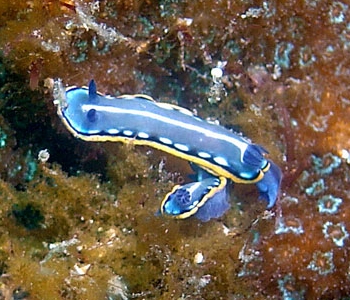
Dear Bill,
This photo of Mexichromis kempfi was taken in Laje de Santos Marine State Park (24º 19' 18" S ; 46º 10' 57" W), Sao Paulo, Brasil.
Locality: Laje de Santos Marine State Park, 12 m, Sao Paulo, Brazil, Atlantic Ocean, 13 October 2006, Rocky bottom. Length: 15 mm. Photographer: Armando de Luca Jr.
Best wishes.
Armando de Luca Jr
mergulho@nautilusdive.com.br
de Luca, A., 2007 (Jan 10) Mexichromis kempfi from Brazil. [Message in] Sea Slug Forum. Australian Museum, Sydney. Available from http://www.seaslugforum.net/find/19152Dear Armando,
This is identical in colour to your earlier photo [message #13281] from Brazil. As I said there, this colour form matches the original description of this species from northern Brazil, and is rather different from the colour pattern of animals from the Caribbean which I have identified as the same species. Perhaps the species has geographic colour variants? It would be nice to compare the anatomy of the two colour forms and perhaps their egg ribbons. There is a photo in Caribbean Sea Slugs of a bright pink egg ribbon, but it seems rather large compared to the size of the slug alongside.
Best wishes,
Bill Rudman
Mexichromis kempfi from Cozumel, Mexico
October 27, 2006
From: Charles Hopf
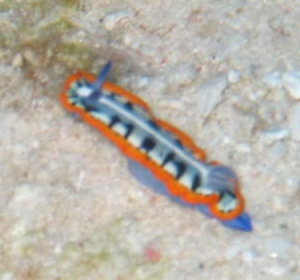
Dear Bill,
Found lots of these on Colombia reef in about 60 FSW. Can you tell me what it is?
Locality: Colombia reef, Cozumel, 60 ft, Mexico, Carribean, 13 October, 2006
Charles Hopf
chuck@chopf.com
Hopf, C., 2006 (Oct 27) Mexichromis kempfi from Cozumel, Mexico. [Message in] Sea Slug Forum. Australian Museum, Sydney. Available from http://www.seaslugforum.net/find/18064Dear Chuck,
This is the very colourful chromodorid nudibranch Mexichromis kempfi. Have a look at the Fact Sheet and earlier messages for more information about it. Until Jim Lyle's recent message [#17544 ], this species wasn't known from this part of the Caribbean.
Best wishes,
Bill Rudman
Mexichromis kempfi from Cozumel
August 22, 2006
From: James Lyle
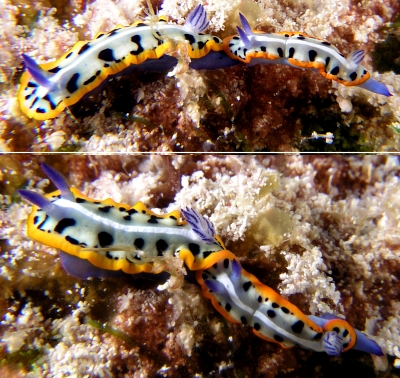
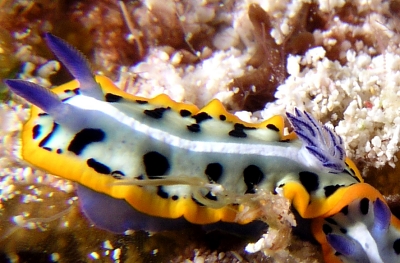
Dr. Rudman,
We were excited to discover two specimens of Mexichromis kempfi (previously described as Chromodoris kempfi ) on a reef in Cozumel, Mexico. This record extends the range of this branch to the Western Caribbean.
Locality: Villa Blanca Reef, Cozumel Island, 15 metres, Quintana Roo, Mexicon, Caribbean, 12 August 2006, coral reef. Length: 20 mm. Photographer: Jim Lyle.
The observed trailing behavior, as previously reported by Anne Dupont and Andres Ahrens, adds to data grouping this branch with other known "trailers" (species of Risbecia and Hypselodoris paulinae ).
Best,
Jim
jlyle@adelphia.net
Lyle, J.L., 2006 (Aug 22) Mexichromis kempfi from Cozumel. [Message in] Sea Slug Forum. Australian Museum, Sydney. Available from http://www.seaslugforum.net/find/17544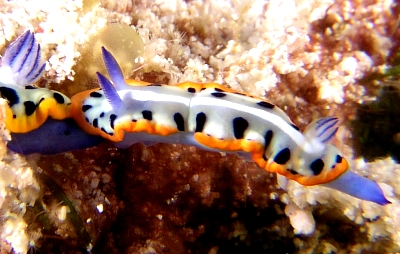
Dear Jim,
Thanks for these great photos. With earlier records from Panama and Colombia, its certainly seems to occur throughout the Caribbean and down into Brazil. It would be good if someone would re-examine its anatomy.
Best wishes,
Bill Rudman
Re: Nudibranch in Little Cayman?
January 17, 2006
From: Matan Ninio
Concerning message #15569:
Hi Bill,
can you add an inlargment of the bottom left forner of the lower photo? Its almost impossible to see the slug hiding there.
thanks,
Matan
matan@forumhasofiot.yam.dive.ninio.org
Ninio, M., 2006 (Jan 17) Re: Nudibranch in Little Cayman?. [Message in] Sea Slug Forum. Australian Museum, Sydney. Available from http://www.seaslugforum.net/find/15583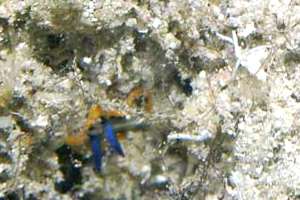
Dear Matan,
I left it small because there was not much to see. Here it is full size. I suspect it is probably best described as being in a patch of debris or the remains of a sponge rather than buried in sand.
Best wishes,
Bill Rudman
Nudibranch in Little Cayman?
January 16, 2006
From: Larissa Roorda
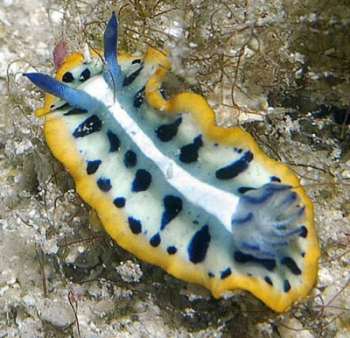
I'm sure this will end up being a common Nudibranch, but I cannot find it in the forum. Notice there's a second one buried in the sand.
Locality: Bloody Bay Marine Park, Little Cayman Island, Caribbean. on reef. Depth: 35 ft., Length: 1 inch. Dec-6-2005. sandy bottom, underneath an overhang. Photographer: Larissa Roorda
Larissa Roorda
larissarda@msn.com
Roorda, L, 2006 (Jan 16) Nudibranch in Little Cayman?. [Message in] Sea Slug Forum. Australian Museum, Sydney. Available from http://www.seaslugforum.net/find/15569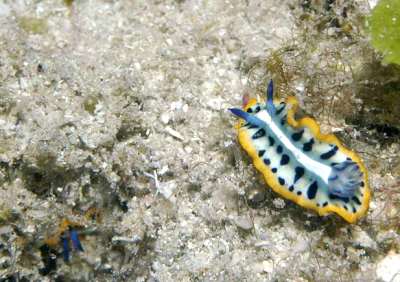
Dear Larissa,
This is Mexichromis kempfi. Not too many Caribbean nudibranchs can be considered 'too common' to be of interest to the Forum at present. We know so little about any of them that any new information is welcome. For example your photos are an example of another colour variation in thsi species. I am also intersted in the burrowing behaviour. I can't say its a behaviour I usually associate with chromodorid nudibranchs.
Best wishes,
Bill Rudman
Mexichromus kempfi from Bonaire
December 15, 2005
From: Les Wilk
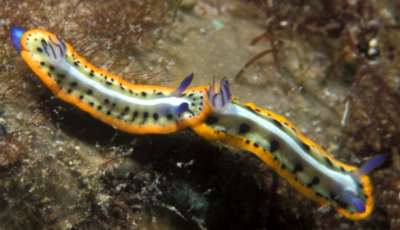
Hi Bill;
Some shots of Mexichromus kempfi from Bonaire. One photo shows the trailing behaviour.
Locality: Bonaire, Caribbean. Depth: 40-50 feet. Length: 0.25 inch. July 2001. reef. Photographer: Keri Wilk
Les Wilk
wilk@reefnet.ca
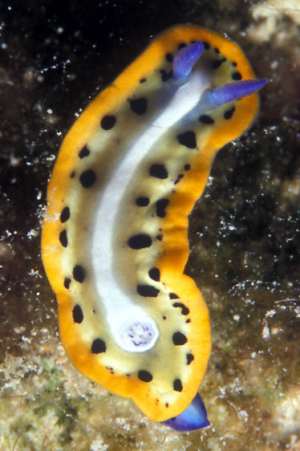
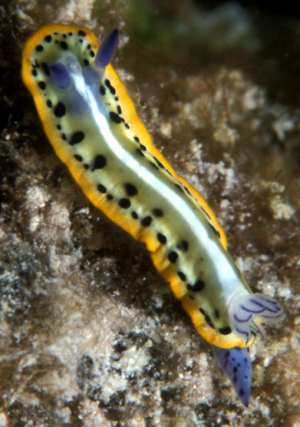
Dear Les,
Thanks for these photos. It is interesting how some species, like this one, are well-known for their trailing behaviour.
Best wishes,
Bill Rudman
Unknown chromodorid from Brazil
March 5, 2005
From: Armando de Luca Junior
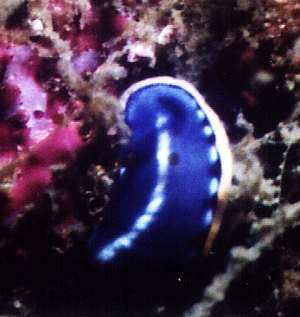
Dear Bill,
Do you know this species of Chromodoris?
Locality: Laje de Santos Marine State Park, Sao Paulo, Brazil. Atlantic Ocean. Depth: 12 metres. Length: 8 mm. 27 February 2005. Rocky bottom. Photographer: Armando de Luca Jr
Armando de Luca Jr
mergulho@nautilusdive.com.br
de Luca, Armando, 2005 (Mar 5) Unknown chromodorid from Brazil. [Message in] Sea Slug Forum. Australian Museum, Sydney. Available from http://www.seaslugforum.net/find/13281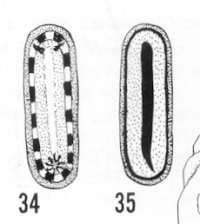
Dear Armando,
If you have more photos of this animal it would be useful as I can't see the gills or the rhinophores clearly, and their colour is often important for identifications. There are a large group of blue chromodorids with white and yellow lines in the Atlantic, and the Mediterranean, and species are often difficult to identify.
In the last major review of these blue chromodorids (Ortea, Valdés & García-Gómez, 1996), a new species, Mexichromis molloi, was described from Venezuela, which is quite similar to your species. The mantle is blue with a white median line, and there is an orange-yellow mantle border, inside of which is a dark blue band and then a white band. The gills and rhinophores are blue and there is a single white line along each side of the blue body.
However your animal matches almost exactly Kempf's sketches of Mexichromis kempfi (Marcus, 1970), which I have copied alongside. What I can't see in your photo is the colour of the foot. If you have another photo or a memory of the foot colour I would be interested to know. If your animal is M. kempfi, the other animals I have identified on the Forum as this species seem rather different but I am pretty sure they are the same species. The major difference is that the lighter blue mantle colour present in your photo, is often absent. However in Phanor Montoya's photos from Colombia [#3209] the pale animals have a dark blue foot. Interestingly, they also show traces of the white line on each side of the foot, which is described for Mexichromis molloi, and suggests that it may in fact be another colour form of M. kempfi. Marcus described M. kempfi from the north coast of Brazil, so your photo extends the known range of the species further south. It is a very useful addition to the Forum as it is the first photo I have seen which matches Kempf's original sketch so accurately.
-
Marcus, E. (1970) Opisthobranchs from northern Brazil. Bulletin of Marine Science, 24: 922-951.
-
Ortea, J., Valdés, A. & and García-Gómez, J.C. (1996) Revisión de las especies atlánticas de la familia Chromodorididae (Mollusca: Nudibranchia) de grupo cromático azul. [Review of the Atlantic species of the family Chromodorididae (Mollusca: Nudibranchia) of the blue chromatic group.] Avicennia, 1996, Suppl. 1: 1-165.
Best wishes,
Bill Rudman
Chromodoris kempfi - 'trailing' behaviour
March 6, 2003
From: Andreas Ahrens
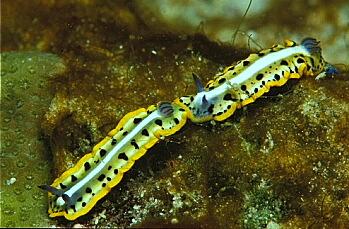
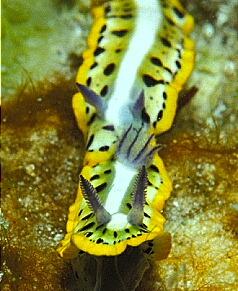
Dear Bill,
Larry's message has reminded me of a pair of slugs I photographed last summer, because "my" slugs also showed that "'trailing' behaviour". I took these photos on 21 August, 2002 on the coast of Bonaire (Netherlands Antilles - Carribean, divesite Reef Scientifico) at a depth of about 12 metres.
The species seems to be Chromodoris kempfi. Anne Dupont has already posted a photo showing this species 'trailing' in Florida. So, now we have another record for 'trailing' in this species and also a record from the Netherlands Antilles.
Andreas
Andreas.Ahrens@hamburg.de
Ahrens, A., 2003 (Mar 6) Chromodoris kempfi - 'trailing' behaviour. [Message in] Sea Slug Forum. Australian Museum, Sydney. Available from http://www.seaslugforum.net/find/9340Thanks Andreas,
I had forgotten Anne's earlier report of this species trailing. Certainly a fascinating topic for someone to study
Best wishes,
Bill Rudman
Correct genus for Chromodoris kempfi
March 19, 2002
From: Elianny Dominguez Tejo
Dear Bill,
You said in an earlier message that Chromodoris kempfi is perhaps a species of Mexichromis or Durvilledoris, because of the radulae. Has someone work on that subject and established the differences? (do you have the complete reference?). Or is C. kempfi still Chromodoris?
Kind regards,
Elianny.
eliannydominguez@hotmail.com
Dominguez Tejo, E., 2002 (Mar 19) Correct genus for Chromodoris kempfi. [Message in] Sea Slug Forum. Australian Museum, Sydney. Available from http://www.seaslugforum.net/find/6448Dear Elianny,
In Eveline Marcus's original description she describes the radula as 'very small' and as having 3-8 denticles, and the jaw rodlets having '2-5 spines'. This is quite unlike the buccal armature of a species of Chromodoris and very similar to that of a species of Mexichromis, which as its name suggests, is based on a species from the Pacific coast of Mexico, M. antonii.
I don't know of any review of the anatomy of Chromodoris kempfi, but I suspect when that occurs, it will turn out to be something other than a species of Chromodoris. My guess would be Mexichromis. If you do intend to look yourself, then be very careful you do not lose the radula. If it is a species of Mexichromis, then the radula will be so small that the whole buccal bulb can be hidden in the oral tube and appear to be absent. In a review of the chromodorid genera (Rudman, 1984) I did suggest that C. kempfi was most probably a species of Mexichromis, but as now, that was based on Marcus's description.
• Marcus, E., 1970. Opisthobranchs from northern Brazil. Bulletin of Marine Science, 24: 922-951.
• Rudman, W.B. (1984) The Chromodorididae (Opisthobranchia: Mollusca) of the Indo-West Pacific: a review of the genera. Zoological Journal of the Linnean Society, 81: 115-273.
Best wishes,
Bill Rudman
Chromodoris kempfi from Colombia
October 20, 2000
From: Phanor Montoya

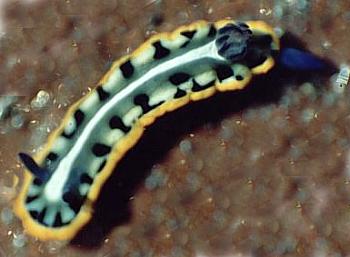
Dear Bill:
I found this nudibranch in coral reef zone [Santa Marta, Colombia - Caribbean coast]. I'm sure It is Chromodoris kempfi . It was 15mm long. Since there are no records from Colombia of this nudibranch, mine will be the first one?
Sincerely yours,
Phanor Montoya
phamont@eudoramail.com
Montoya, P., 2000 (Oct 20) Chromodoris kempfi from Colombia. [Message in] Sea Slug Forum. Australian Museum, Sydney. Available from http://www.seaslugforum.net/find/3209Dear Phanor,
The only records I know of this animal are from the original description from Brazil, from the Caribbean end of the Panama Canal (Meyer, 1977), Anne Dupont's record here in the Forum from Florida, and Humann's book which has records from Florida keys and Bahamas. So you are indeed the first person to record it from Colombia.
If you have kept the specimen, it would be of interest to look at its anatomy because the multicuspid jaw rodlets and very very small multidenticulate teeth described by Marcus, make it very unlikely that this is a species of Chromodoris. It is perhaps a species of Mexichromis or Durvilledoris.
Best wishes,
Bill Rudman.
Chromodoris kempfi? from Colombia's Caribbean coast
March 31, 2000
From: P. Montoya
I have found in Santa Marta, Colombia a nudibranch that seems to be Chromodoris kempfi. I took a look at the articles wrote by Marcus and his wife about the opisthobranch of the Santa Marta region and they don´t mentioned this species for this area. Do you know if there are notes about the presence of this species in the waters of Colombia?
Phanor Montoya
phamont@eudoramail.com
Montoya, P., 2000 (Mar 31) Chromodoris kempfi? from Colombia's Caribbean coast. [Message in] Sea Slug Forum. Australian Museum, Sydney. Available from http://www.seaslugforum.net/find/2172Dear Phanor,
Have you any photos? or does it look like the animal at the top of this page? As far as I know there are records of this species from northern Brazil, Florida and the Caribbean end of the Panama Canal. So it seems to be widespread Caribbean species which you would expect to find on the Caribbean coast of Colombia. Most of the Marcus's papers were based on small collections made by non-specialist collectors. They were never comprehensive so an absence from one of these collections is not an indication that a particular species does not occur in that area.
Best wishes,
Bill Rudman.
Chromodoris kempfi from Florida
October 11, 1999
From: Anne Dupont
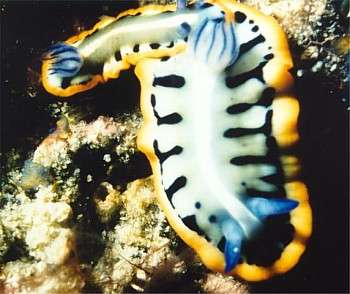
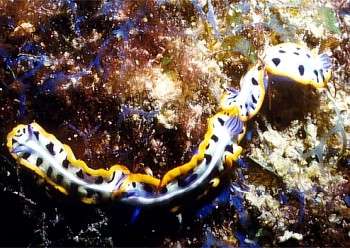
Hi Bill,
I have photographed this nudibranch on our reefs here in Florida over the years.
They are usually found on top of the reef in about 60 feet of water in the algae. The book that I have calls it a purple-crowned sea goddess, Chromodoris kempfi.
I have two questions, (1) Can you identify it and (2) is this mating behavior?
I'm sending you another photo showing 4 of the critters together. I have seen them alone, two together, three together and four together.
Thank you for your time.
Cordially,
Anne
adupont@gate.net
Dupont, A., 1999 (Oct 11) Chromodoris kempfi from Florida. [Message in] Sea Slug Forum. Australian Museum, Sydney. Available from http://www.seaslugforum.net/find/1415Dear Anne,
Your animals certainly fit the original description of Chromodoris kempfi, which was originally described from northern Brazil. It has been subsequently been recorded from the Caribbean coast of Panama and Florida. I very much doubt that it will remain in the genus Chromodoris when its anatomy is fully investigated as Marcus's original description described multicuspid jaw platelets and a very small radular ribbon which is quite unlike Chromodoris. It is possibly a species of Mexichromis, of which there are a number of species on the east Pacific coast of central America.
The 'trailing' behaviour may be a precursor to mating, but as their genital opening is on the right side they need to be arranged alongside each other, right-side to right-side, for mating to occur. The trailing observation is very interesting because it has previously been observed only in species of Risbecia and one Hypselodoris, Hypselodoris paulinae. If you Search the Forum for trailing you will get a list of messages and photos on the subject.
Thanks again,
Bill Rudman.
